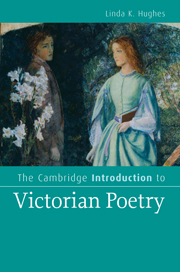Book contents
- Frontmatter
- Contents
- List of figures
- Preface
- Acknowledgments
- Editions cited
- Introducing Victorian poetry
- Part I The forms of Victorian poetry
- 1 Victorian experimentalism
- 2 Victorian dialogues with poetic tradition
- 3 The impress of print: poems, periodicals, novels
- Part II The rhetoric of Victorian poetry
- Part III Coda Close readings
- Glossary
- Notes
- Further reading
- Index
- Cambridge Introductions to Literature
1 - Victorian experimentalism
Published online by Cambridge University Press: 05 June 2012
- Frontmatter
- Contents
- List of figures
- Preface
- Acknowledgments
- Editions cited
- Introducing Victorian poetry
- Part I The forms of Victorian poetry
- 1 Victorian experimentalism
- 2 Victorian dialogues with poetic tradition
- 3 The impress of print: poems, periodicals, novels
- Part II The rhetoric of Victorian poetry
- Part III Coda Close readings
- Glossary
- Notes
- Further reading
- Index
- Cambridge Introductions to Literature
Summary
The shapes of things, their colours, lights and shades,
Changes, surprises,
– Robert Browning, “Fra Lippo Lippi” (1855)All literary writing is mediated by form, but poetry's very look on the page and sounds during recitation call attention to its artifice. Closely adhering to forms handed down over time might preserve and pay tribute to the past but can also stifle invention or dissent. Beginning with Wordsworth's preface to Lyrical Ballads (1802), nineteenth-century poets repeatedly argue for new ways of approaching poetic language and meter. In a century anxious about revolutions but also propelled by innovation in industry and the marketplace, the “new” became a desirable feature of poetry, especially as increased publishing opportunities required poets to distinguish themselves both from precursors and from numerous contemporaries. Modernity and a market-driven economy thus helped encourage what has always been a feature of memorable poetry: its ability to connect with readers yet repeatedly surprise them by unexpected turns in thought, image, language, or form. Experimentalism, then, is another defining feature of Victorian poetry. Because the dramatic monologue is so often cited as its distinctive development, I begin there.
Dramatic monologue
First-person utterances by fictive characters predate the Victorian era in Shakespearean and other dramatic soliloquy as well as in a long line of laments and declamations. The Victorian dramatic monologue departs from precedent insofar as it operates within a problematical epistemology and demands that readers negotiate a range of ambiguities. Does the poet agree with what the character is saying?
- Type
- Chapter
- Information
- The Cambridge Introduction to Victorian Poetry , pp. 15 - 39Publisher: Cambridge University PressPrint publication year: 2010

